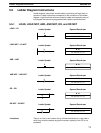
81
will not be changed. Each of these jump numbers can be used to define one
jump. Because all of instructions between JMP(04) and JME(05) are skipped,
jump numbers 01 through 08 can be used to reduce cycle time.
If the jump number for JMP(04) is 00, the CPU will look for the next JME(05)
with a Jump number of 00. To do so, it must search through the program,
causing a longer cycle time than for other jumps (i.e., longer when the execu-
tion condition is OFF). The status of timers, counters, bits used in OUT, bits
used in OUT NOT, and all other status controlled by the instructions between
JMP(04) 00 and JMP(05) 00 will not be changed. Jump number 00 can be
used as many times as desired. A jump from JMP(04) 00 will always go to
the next JME(05) 00 in the program. It is thus possible to use JMP(04) 00
consecutively and match them all with the same JME(05) 00. It makes no
sense, however, to used JME(05) 00 consecutively, because all jumps made
to them will end at the first JME(05) 00.
Although DIFU(13) and DIFD(14) are designed to turn ON the designated bit
for one cycle, they will not necessarily do so when written between JMP(04)
and JMP (05). Once either DIFU(13) or DIFD(14) has turned ON a bit, it will
remain ON until the next time DIFU(13) or DIFD(14) is executed again. In
normal programming, this means the next cycle. In a jump, it means the next
time the jump from JMP(04) to JME(05) is not made, i.e., if a bit is turned ON
by DIFU(13) or DIFD(14) and then a jump is made that skips the DIFU(13) or
DIFD(14), the designated bit will remain ON until the next time the execution
condition for the JMP(04) controlling the jump is ON.
When JMP(04) and JME(05) are not used in pairs, an error message will ap-
pear when the program check is performed. Although this message also ap-
pears if JMP(04) 00 and JME(05) 00 are not used in pairs, the program will
execute properly as written.
There are no flags affected by these instructions.
5-9 END – END(01)
Ladder Symbol
END(01)
END(01) is required as the last instruction in any program. No instruction
written after END(01) will be executed. END(01) can be placed anywhere in
the program to execute all instructions up to that point, as is sometimes done
to debug a program, but it must be removed to execute the remainder of the
program.
If there is no END(01) in the program, no instructions will be executed and
the error message “NO END INST” will appear.
END(01) turns OFF ER, CY, GR, EQ, and LE.
5-10 NO OPERATION – NOP(00)
NOP(00) is not generally required in programming and there is no ladder
symbol for it. When NOP(00) is found in a program, nothing is executed and
the next instruction is moved to. When memory is cleared prior to program-
ming, NOP(00) is written at all addresses. NOP(00) can be input through the
00 function code.
There are no flags affected by NOP(00).
DIFU(13) and DIFD(14)
in Jumps
Precautions
Flags
Description
Flags
Description
Flags
NO OPERATION – NOP(00) Section 5-10


















